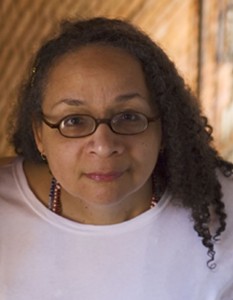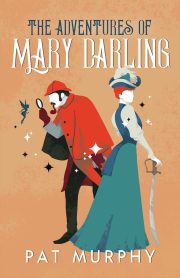Transracial Writing for the Sincere
by Nisi Shawl
“I’d never write about a person from a different ethnic background. The whole story would probably be full of horrible stereotypes and racist slurs.”
Amy closed her mouth, and mine dropped open. Luckily, I was seated when my friend made this statement, but the lawn chair must have sagged visibly with the weight of my disbelief. My own classmate, excluding all other ethnic types from her creative universe!
I think this sort of misguided caution is the source of a lot of sf’s monochrome futures. You know the ones I mean, where some nameless and never discussed plague has mysteriously killed off everyone with more than a hint of melanin in their skin. I wonder sometimes what kind of career I’d have if I followed suit with tales of stalwart Space Negroes and an unexplained absence of whites.
But of course I don’t. I boldly write about people from other backgrounds, just as many of the field’s best authors do. Suzy McKee Charnas, Bruce Sterling, and Sarah Zettel have all produced wonderful transracial characters, as I show in examples below. Before getting into their work, though, let’s discuss how to prepare for your own.
If you want to go beyond the level of just assigning different skin tones and heritages to random characters, you’re going to have to do some research. Because yes, all people are the same, but they’re also quite different. For now, we’ll set aside the argument that race is an artificial construct, and concentrate on how someone outside a minority group can gain enough knowledge of the group’s common traits to realistically represent one of its members.
Reading’s a very non-confrontational way to do this. Be sure, though, if you choose this route, to use as many primary sources as possible. If researching a story about first contact between a stranded explorer from Aldeberan and a runaway slave, for example, you’d do much better reading The Life & Times of Frederick Douglass than Uncle Tom’s Cabin. The latter is an important and moving book. But not only is it a work of fiction, it was written by a non-slave; therefore it’s a step further removed from the authentic experience you need.
Websites on minority culture abound. Any half-decent search engine will bring up a freighter’s worth of URLs on African-Americans, for instance, and at least a line or two on lesser-known groups.
For a less cerebral approach, check out nearby ethnic history museums. Art collections, historical dioramas, anthropological displays and so on can provide you with strong visuals. Some are interactive, and allow you to pick up a few aural and tactile sensations as well. For locations, look under “Museums” in the yellow pages, or consult a travel guide for your area.
When it comes to finding more contemporary material, magazines help. I also strongly recommend shopping trips, night-clubbing and restaurant hopping. Take a walk on the wild side. Do you feel like a tourist? Uncomfortable? Well, you are one, and you need to know what it’s like to be conspicuous. If your character’s a minority, she or he will be quite familiar with the sensation. Bruce Sterling once told me that alienation is an essential part of any science fiction writer’s education, and I agree.
Perhaps you have friends of other cultural backgrounds. Talk to them. Explain what you’re trying to do. Even though no one is a certified representative of their own ethnic group, they can let you know when something you propose is totally out of whack. And they can point you to sources of specific info.
If you’re thinking of approaching someone who’s more an acquaintance than a friend, offer to buy them lunch, or dinner, and make the interaction a formal interview. This is what you’d do with anyone else you wanted to pump for valuable data. Cultural background is data. If you want it, and you don’t have it, it’s valuable; treat it that way.
Above all, don’t rely on representations of minorities gleaned from popular culture. They’re as true to life as Donna Reed’s pearl-laden floor-waxing outfits.
So now that you’ve got some background on these Beautiful Strangers, how best to use it?
A lot depends on your piece’s point of view, and the size of a given character’s role within it. Let’s start with Charnas’ short story, “The Ancient Mind At Work,” in which the protagonist, a white immigrant from South Africa, views an African American man:
Katje never called him by his name because she didn’t know whether he was Jackson Somebody or Somebody Jackson, and she had learned to be careful in everything to do with blacks in this country.
He was slender as a Kikuyu youth–she could see his ribs arch under his shirt . . . By rights he belonged in a red blanket, skin gleaming with oil, hair plaited. Instead he wore the tan shirt, pants, and zip-up jacket of an ‘engineer’ from Buildings and Grounds, and his hair was a modest Afro, as they called it, around his narrow face.
Here we see the minority through the eyes of another minority, but one sharing many assumptions with this society’s rulers. Katje’s opinions about what this man “should” be wearing and doing throw our own preconceptions in relief by their extremity. Her caution in dealing with Jackson underscores that of most American whites.
On a few occasions, Charnas has Jackson speak for himself:
“Try and don’t put nobody in that number-six bedroom till I get to it at the end of the week,” he said.
“I got accepted in Computer school in Rochester next semester . . . they don’t do blacks with guns . . .”
Jackson’s speech reflects patterns familiar to anyone who’s ever listened to or talked with blacks of a certain upbringing. But it doesn’t lapse into incomprehensible “Buckwheatisms”; it marks difference, not inferiority. The combination of honest, foreign prejudice, familiar tension, and Jackson’s voicing of his own concerns produces a picture in slightly more than two dimensions, all that’s necessary for a supporting character.
Sterling’s “Green Days In Brunei” features a multi-transracial cast; main and most supporting roles are filled by people of very different races than the author’s own. On assignment for a Japanese corporation, Turner Choi, a twenty-six year old Chinese Canadian CAD CAM engineer, becomes slowly accustomed to the ways of a tiny, somnolent country near Borneo, and its mix of Malaysian, Chinese, Iban, Dayak and European citizenry. Novella length gives Sterling room to flesh Choi out, using comparisons to his stay-at-home lawyer brother and his domineering, bad-cop, drug tycoon of a grandfather. A non-Asian girlfriend calls him “about as Chinese as maple syrup. . .” A Malaysian princess sees his status as a Western techie as exotic.
Choi’s observations of his surroundings reveal as much about himself as they do about Brunei. The gossipy, village-like kampongs which run the city’s retro-greened high-rises inhibit his bachelor lifestyle. The Dayaks are his exotics, the “dark, beautiful descendants of headhunting pirates, dressed in hand-dyed sarongs and ancient plastic baseball caps,” their language “utterly incomprehensible.”
Otherness is not a uniform state. Non-whites are not indentical, interchangeable units. Choi’s sense of himself as a foreigner, as a Westerner, a Northerner, and a child of privilege, complicates all his interactions. Age, more than race, distances him from the white exile Brooke, with whom he might otherwise form an alliance.
It’s mostly Choi’s gear-headedness that defines him for himself. He learns the obsolete programming language required for his assignment so well he dreams in it. And he sees his love for Princess Seria as defined by tech:
The painfully simple local Net filtered human relations down to a single channel of printed words, leaving only a high-flown, Platonic essence. Their relationship had grown into a classic, bloodless, spiritual romance . . .
Being a gear-head in low-and-appropriate tech Brunei causes Choi’s most alienated moments, and allows Sterling his closest identification with the character.
Katmer Al Shei, a heroine of the novel Fool’s War, shares several characteristics with her creator, Sarah Zettel. They’re both women of low stature and high determination. Both rely on discipline and humor to help them deal with trying situations.
For Al Shei, this includes an encounter with a “gerbil,” or space-station worker, who assaults her near the book’s beginning:
“Oh, sorry,” said a man’s bland voice. “I didn’t see a person there. I thought it was just a pile of rags and shit.
Al Shei pulled herself upright and turned around slowly to face the chestnut skinned, auburn-haired, totally unshaven can-gerbil.
She drew herself up to her full height. “There is no god but Allah and Muhammed is the Prophet of Allah.” Reciting the first pillar of Islam loudly was her standard tactic. Bigots seldom know how to reply to a declaration of faith . . .
Long before this early and explicit confrontation, Zettel establishes Al Shei’s otherness, with descriptions of the veils she and her cousin wear, and their integration of prayer into starship routine.
She also gives us a good idea of the context of this otherness. Coloring is noted: Master Fool Evelyn Dobbs’ skin is “a clear brown, two or three shades lighter than Al Shei’s earth tones. That and the angles in her eyes and her face said a good chunk of her ancestry was European.” And “shockingly blue eyes” shine out of Al Shei’s brother-in-law Tully’s “medium brown face.” But the roots of this society’s major prejudices lie in a dislike of certain strongly held beliefs. And right down there with the Muslims in terms of popularity is a group called “Freers.”
Freers have revolutionary ideas concerning A.I.s and their occasional emergence into self-awareness. Since these chaotic births usually result in the loss of human life, most people think Freers are insane to encourage them.
Fool’s War’s narrative switches between Al Shei, a target of religious persecution, Freer Jemina Yerusha, and Evelyn Dobbs, who has her own reasons for fearing irrational hatred. Though they all experience prejudice, the heroines’ goals aren’t quite congruent. Again, varying view points and sources of otherness give the story verisimilitude.
One more note on Fool’s War: Zettel makes a conscious effort to avoid equating non-European skin tones with food. In fact, she does the opposite, writing of Com Engineer Lipinski’s “pale, exotic good looks” in terms of milk and lobsters, which she contrasts with the more customary copper, bark brown, chestnut, etc. A friend pointed out to her the annoying frequency of references to coffee and chocolate as racial color analogies. Humans have been treated as commodities in this hemisphere’s recent past. The connection to slavery was subtle, but disturbing, and Zettel has done what she can to reverse the trend.
So let’s review how you, too, can make your universe an equal opportunity employer.
First, get to know your subjects. Primary sources are best.
When telling your story from any character’s viewpoint, be true to their take on the situation. Don’t give them your own anachronistic beliefs, or inauthentic, “p.c.” motivations.
Allow minority characters to speak with their own voices, even if only in a brief comment. Contrasts between multiple viewpoints produce both diversity and depth.
Show how race and prejudice figure in your setting, and what, if any, their connections.
Remember that difference is in the eye of the beholder. Black people don’t spend their whole lives thinking of themselves as black. We’re Ghanaians and editors and diabetics, and lots of other -ians and -ors and -ics. Use these self-categorizations to add points of audience identification to your characters.
Finally, offer your work to members of other ethnic groups for critique. You don’t have to follow their suggestions, but it won’t hurt to hear them.
Tom Wolfe spoke at a Press Club lunch on the subject of “writing what you know.” His point was that this is great advice, but that as writers it’s our job to continually know more.
This is true for SF writers in spades cubed. If we can’t create a reasonable facsimile of the local cigar shop’s owner, how much of a chance do we have of convincing readers they understand the Ganymedian group mind’s ambassador?
So welcome the Beautiful Strangers. Don’t be afraid to make mistakes with them. Do your best, and you’ll avoid the biggest mistake of all: exclusion.
—
 “Transracial Writing for the Sincere” is available in print from Aqueduct Press as part of the Tiptree Special Mention book Writing the Other, a guide to developing characters of varying backgrounds by Nisi Shawl and Cynthia Ward.
“Transracial Writing for the Sincere” is available in print from Aqueduct Press as part of the Tiptree Special Mention book Writing the Other, a guide to developing characters of varying backgrounds by Nisi Shawl and Cynthia Ward.
Nisi Shawl’s story collection Filter House won the 2008 James Tiptree, Jr. Award and was nominated for a 2009 World Fantasy Award. She received a second 2009 World Fantasy Award nomination for her novella “Good Boy.” Shawl is the coeditor, with Dr. Rebecca Holden, of Strange Matings: Science Fiction, Feminism, African American Voices, and Octavia E. Butler (forthcoming). Her reviews and essays appear in the Seattle Times and Ms. Magazine, and she has contributed to Women in Science Fiction and Fantasy and The Encyclopedia of Themes in Science Fiction. Shawl is a founding member of the Carl Brandon Society and serves on the Board of Directors of the Clarion West Writers Workshop, which she attended in 1992.


